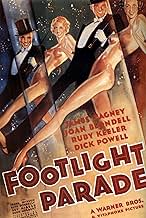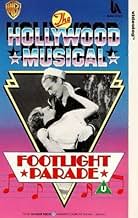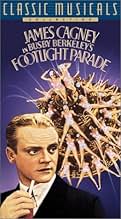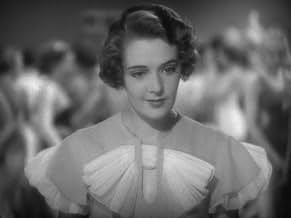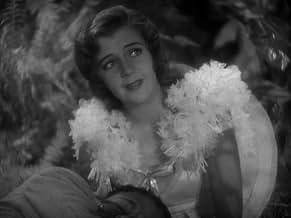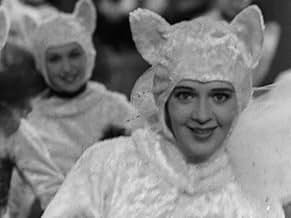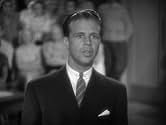Füge eine Handlung in deiner Sprache hinzuChester Kent struggles against time, romance, and a rival's spy to produce spectacular live "prologues" for movie houses.Chester Kent struggles against time, romance, and a rival's spy to produce spectacular live "prologues" for movie houses.Chester Kent struggles against time, romance, and a rival's spy to produce spectacular live "prologues" for movie houses.
- Auszeichnungen
- 3 wins total
- Chorus Girl
- (Nicht genannt)
- Chorus Girl
- (Nicht genannt)
Empfohlene Bewertungen
Sure, Warner Bros. tries to cover the orgy with the fig leaf of two cheerful innocents played by a sappy Dick Powell and a virginal Ruby Keeler. But it doesn't work, because everyone else gets in on the fun, including that human buzz-saw Jimmy Cagney and everyone's favorite sassy dame Joan Blondell. Director Lloyd Bacon proves too he knows what to do, giving us an eyeful of Blondell endlessly rolling and unrolling her hosiery, while the writers pepper the conversation with suggestive one-liners. Yeah, it's a great movie-- good enough to help bring down the heavy hand of censorship the following year, and put an end to damp dreams like "Beside a Waterfall". But not even the Watchdogs of Public Morality could stop Berkeley's deliriously suggestive pageantry that would live on at even that most repressed of studios, MGM. Sure, Astaire-Rogers may have been more graceful and a whole lot more chaste, no doubt producing more sheer polish-- still and all, don't let this unabashedly pagan celebration pass you by. As they say around the owl cage, it's a real hoot.
Cagney develops live musical prologues to be shown on stage at movie houses before the start of a film. (If you've seen the "Let's Go To The Movies" number in ANNIE you get the idea.) It's one catastrophe after another as Cagney tries to keep things running smoothly while staying a step ahead of the competition.
Joan Blondell is great as Cagney's secretary, who loves him more than he realizes. The solid cast also includes Busby Berkeley regulars Dick Powell and Ruby Keeler as a young new tenor and a secretary-turned- leading lady, respectively, with Frank McHugh as the perpetually worried dance instructor and Hugh Herbert as the morality adviser/censor. Lloyd Bacon directs the showbiz tale, with spectacular choreography by the inimitable Busby Berkeley.
I've seen this film's contemporaries (42ND STREET and GOLD DIGGERS OF 1933) and usually feel lukewarm toward these early musicals, but I found myself surprisingly receptive to FOOTLIGHT PARADE. I really liked Blondell's performance, with the romantic tension and snappy wit, and I could tolerate Keeler in her role. McHugh adds whiny comic relief and the script has some racy pre-Code touches. The film also benefits from James Cagney's screen presence. Cagney, best known for his gangster roles, demonstrates some dance steps in this rare musical appearance.
Berkeley choreographs a handful of routines (including an awkward cat- themed number), but saves the three biggest for the very end: "Honeymoon Hotel", "By A Waterfall", and "Shanghai Lil". As was often the case, the dance numbers are meant to be staged within the context of the story (a show within a show) and as was always the case, Berkeley choreographs cinematically, using camera movements, insert shots, and cuts that make no sense within the reality of the story. But his routines are meant for the moviegoers and they are awe-inspiring.
The water nymph routine will blow you away. I've seen my fair share of Busby Berkeley numbers, but the water nymph sequence may be his masterpiece. Did Berkeley invent synchronized swimming? I don't know, but he might as well have. There are unbelievable kaleidoscopic overhead shots as well as underwater choreography. I can't figure out how they did the shot of the swimmers in concentric rings, spinning in different directions, since the swimmers seemed to be lying still in the water. (Movie magic?) The more complex overhead shots are some of the most impressive visuals I've ever seen in a musical.
"Honeymoon Hotel" is a racy little number about couples spending their first night together in a hotel. Men in pajamas, women in negligees, bedrooms. There's a peculiar "child" that runs around causing mischief, but the scene has a neat larger-than-life dollhouse shot and a creative bit of stop-motion animation. "Shanghai Lil" follows a sailor through a crowded saloon in search of an elusive woman. There's a brawl, there are marching soldiers in formation, there's Ruby Keeler dolled up like a Chinese call girl, and there's Jimmy Cagney dancing and singing.
With a great cast and impressive dances, this is an enjoyable ride. Maybe the best of the early WB musicals.
Busby, of course, is the undisputed master of the Hollywood musical with "Gold Diggers of 1933" and "42nd Street" to his credit (as Dance Director). Footlight Parade is graced by hundreds of scantily-clad chorus girls, a Berkeley trademark. The elaborate dance numbers were shot with only one camera and Busby was the first director to film close-ups of the dancers. His obsession with shapely legs and "rear-view" shots is amply demonstrated here. The overall effect is highly erotic and mesmerizing.
Our boy Jimmy Cagney plays Chester Kent, a producer of "prologues" or short musical stage productions that were performed in movie theaters to entertain the audience before the talkies were shown. He's surrounded by crooked partners, a corporate spy, and a gold-digging girlfriend. Although Cagney had a solid background in vaudeville, this was the first film in which he showed his dancing talents. Joan Blondell is memorable as Cagney's wise-cracking, lovestruck secretary. And Ruby Keeler is adorable, as always.
The film climaxes with three outstanding production numbers, "Honeymoon Hotel", "The Waterfall", and "Shanghai Lil", each one a masterpiece and not likely to be duplicated in today's Hollywood where so-called "special effects" have replaced creative cinematography.
Claudia's Bottom Line: Clever and erotic, with some of the best musical production numbers ever put on celluloid. A thoroughly enjoyable Depression era romp.
The first half of "Footlight Parade" is preparation for a musical extravaganza which occupies the last half of the film. Chester Kent (Cagney) is about to lose his job and does lose his playgirl wife as a result of talking pictures squeezing out live stage musicals. His producers take him to see a popular talky of the day, John Wayne in "The Big Trail." Before each showing of the flick, a dance number is presented as a prologue. Shorts, news reels, serials, and cartoons would later serve the purpose. Kent gets the idea that a prologue chain would be the road to salvation for the dwindling live musical business. Kent is basically an idea man along the lines of choreographer Busby Berkeley. Could it be that Cagney's character is patterned after Berkeley? Could be.
In preparation for the prologues, Kent learns that his ideas are being stolen by a rival. He uncovers the traitor, fires him, then unbeknown to him a new leak is planted in the form a dazzling temptress. His assistant, Nan Prescott (Joan Blondell - soon to be Mrs. Dick Powell) has the hots for Kent and is determined to expose the wiles of the temptress. A new singer from Arkansas College shows up in the form of Scotty Blain (Dick Powell) who turns out to be a real find and is paired with Bea Thorn (Ruby Keeler). The resulting three prologue musicals, which couldn't possibly have been presented on any cinema stage of the day, are as fresh and enjoyable today as they were over seventy years ago, "Honeymoon Hotel," "By a Waterfall," and "Shanghai Lil."
Of special note is the song and dance of tough-guy James Cagney. Like Fred Astaire and Bill "Bojangles" Robinson, Cagney's dancing appeared natural and unrehearsed, although hours went into practice to get each step just right. Not as good a singer as Astaire, Cagney's singing, like Astaire's, sounded natural, unlike the crooning so popular at the time. It's amazing that one person could be so talented and so versatile as James Cagney.
Most critics prefer the "Shanghai Lil" segment over the other two. Yet the kaleidoscopic choreography of "By a Waterfall" is astonishing. How Berkeley was able to film the underwater ballets and to create the human snake chain must have been difficult because it has never been repeated. The close up shots mixed brilliantly with distant angles is a must-see. The crisp black and white photography is much more artistic than it would have been if shot in color.
Though not nearly as socially conscious as "Gold Diggers of 1933," "Footlight Parade" stands on its own as one of the most amazing and outrageous musicals ever put on the big screen.
Wusstest du schon
- WissenswertesFirst film where James Cagney dances - showing off his vaudeville and stage experience as a song-and-dance man. Cagney lobbied Warner Bros. to play this role. He would show off these talents to their fullest in Yankee Doodle Dandy (1942).
- PatzerAfter the "By A Waterfall" prologue ends, the film cuts to the audience giving an animated and thunderous applause, but in the balcony there is no applause or reaction. In fact, there is no movement whatsoever. They are perfectly still which indicates that a photo or painting was used for the balcony audience and then merged with the live theatre audience. The same photo/painting was also used for the "Shanghai Lil" balcony audience.
- Zitate
Nan Prescott: You scram, before I wrap a chair around your neck!
Vivian Rich: [Angrily] It's three o'clock in the morning - where do you want me to go?
[Nan starts to speak, but Vivian immediately cuts her off]
Vivian Rich: You cheap stenographer...
Nan Prescott: Outside, countess. As long as they've got sidewalks YOU'VE got a job.
[Shoves her out, gives her a swift kick in the rump, and slams the door behind her]
- Alternative VersionenThere is an Italian edition of this film on DVD, distributed by DNA srl, "VIVA LE DONNE! (1933) + AMORE IN OTTO LEZIONI (1936)" (2 Films on a single DVD), re-edited with the contribution of film historian Riccardo Cusin. This version is also available for streaming on some platforms.
- VerbindungenEdited into Busby Berkeley and the Gold Diggers (1969)
- SoundtracksA Vision of Salome
(1908) (uncredited)
Music by J. Bodewalt Lampe
Played during the prologue scene in the movie theater
Top-Auswahl
Details
- Erscheinungsdatum
- Herkunftsland
- Sprachen
- Auch bekannt als
- Chester übertrifft sich selbst
- Drehorte
- Produktionsfirma
- Weitere beteiligte Unternehmen bei IMDbPro anzeigen
Box Office
- Budget
- 703.000 $ (geschätzt)
- Weltweiter Bruttoertrag
- 276 $
- Laufzeit
- 1 Std. 44 Min.(104 min)
- Farbe
- Seitenverhältnis
- 1.37 : 1



